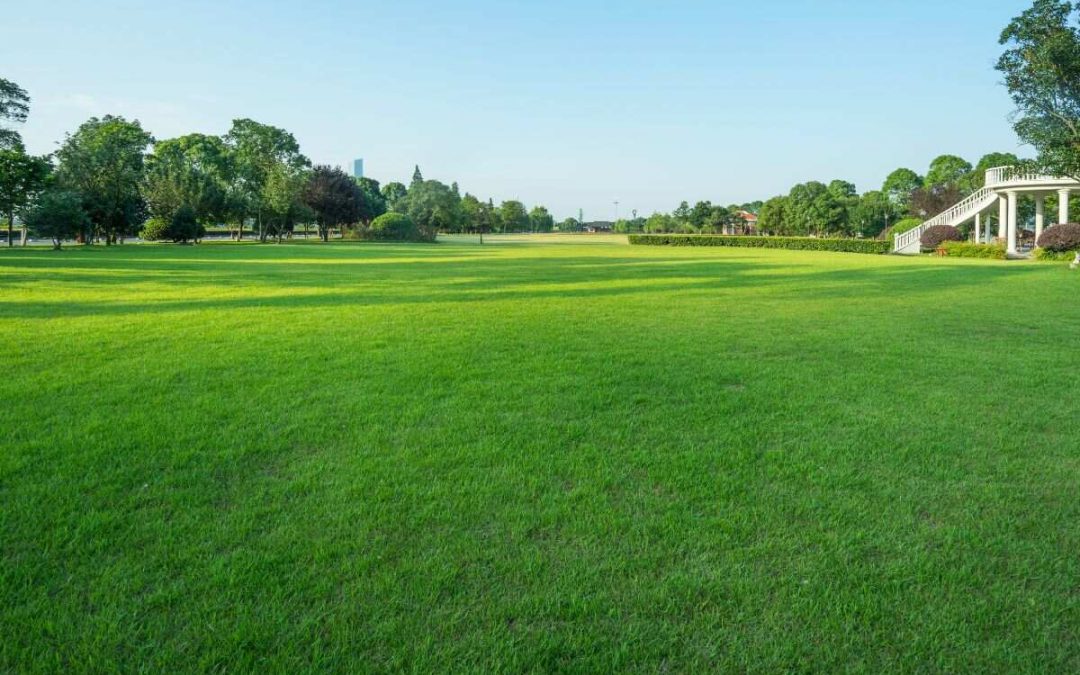Los Angeles is a vibrant city with stunning beaches and a moderate climate, but rainfall can be a little iffy. So if you’re looking to create a lush green lawn that can withstand the heat and dry conditions of the region, it’s important to know the best grass types for the City of Angels.
In this article:
- 7 Warm-Season Grasses for Los Angeles
- FAQ About Los Angeles Grass Types
- Choose the Right Grass and Plants for Your Los Angeles Landscape
7 Warm Season Grasses for Los Angeles
All grasses are classified into one of these two categories:
- Warm-season grasses grow most actively in late spring and summer when temperatures are around 75 to 95 degrees Fahrenheit. They perform best in the southern half of the United States.
- Cool-season grasses grow most actively in early spring and fall when temperatures are around 55 to 75 degrees Fahrenheit. They’re well-suited to northern climates with distinct seasons and cold winters.
Los Angeles is warm throughout the year, with sunny summers and mild winters. Because of this, cold-season grasses typically don’t do well in Los Angeles. Warm-season grasses obviously handle high temperatures and drought better.
Let’s take a closer look at some of the best warm-season grass types for Los Angeles below.
1. Native California Bentgrass
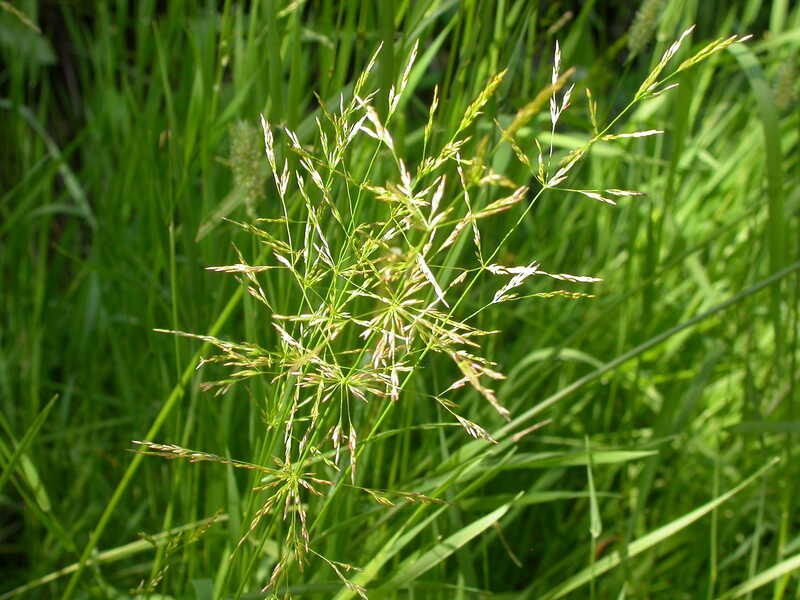
Photo Credit: Matt Lavin / Flickr / CC BY-SA 2.0
Los Angeles’ warm climate is a breeze for native California bentgrass. This grass stays a deep green color whether it’s in the sun or in the shade. It tolerates drought as well as moderate moisture.
The grass is low-maintenance; you can let it grow and form a meadow or cut it as you wish. However, be careful not to cut it very short after leaving it long because this can shock this grass. Its medium texture and uniform growth habit make it a perfect addition to any LA lawn.
The downside of this grass is that it takes a long time to grow. It’s available as sod, but because the grass grows slowly, sod is more expensive than alternatives.
Classification: Warm-season grass
Spreads by: Stolons and rhizomes
Drought tolerance: High
Foot traffic tolerance: High
Shade tolerance: Medium; full sun to partial shade
Maintenance needs: Low; but mowing must be consistent or the grass must be left to grow freely; also takes a long time to grow
Recommended mowing height: Up to you; naturally grows up to 4 to 28 inches; mow consistently to avoid scalping; in any case, never remove more than 1/3 of the leaf blade per mow
2. Sand Dune Sedge
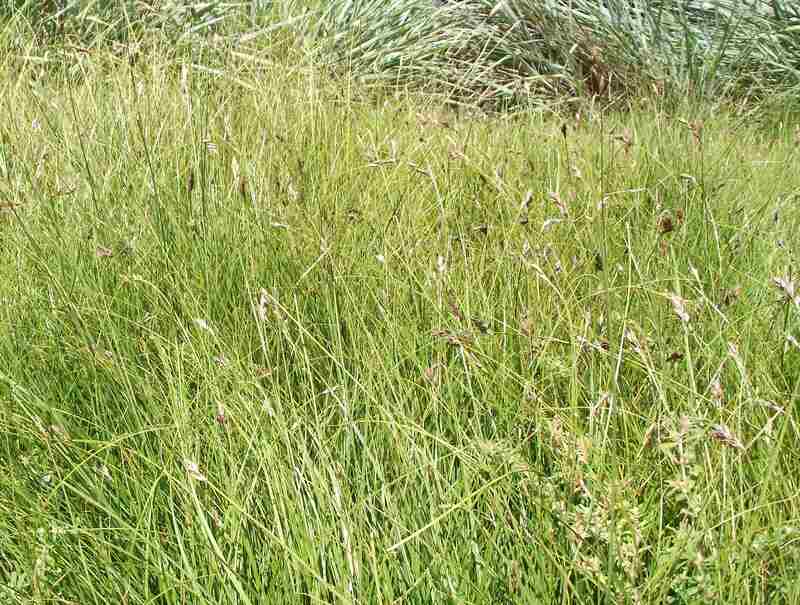
Photo Credit: Tortie tude / Wikimedia Commons / CC0 1.0
You may have seen this shade- and drought-tolerant perennial grass on your local beach, but did you know that it can also grow on your lawn? Sand dune sedge tolerates various soil types and is low-maintenance. You can grow it long or mow it regularly to keep it short and tidy.
The unique texture and color of the sand dune sedge makes it a fantastic addition to your landscape design. But keep in mind that it grows in clumps, so it’s not the best option for a uniform, carpet-like lawn.
Classification: Warm-season grass
Spreads by: Rhizomes
Drought tolerance: High
Foot traffic tolerance: Moderate
Shade tolerance: Low
Maintenance needs: Low
Recommended mowing height: Up to you; naturally grows up to 0.7 to 1.3 ft tall; never remove more than 1/3 of the leaf blade per mow
3. Bermudagrass
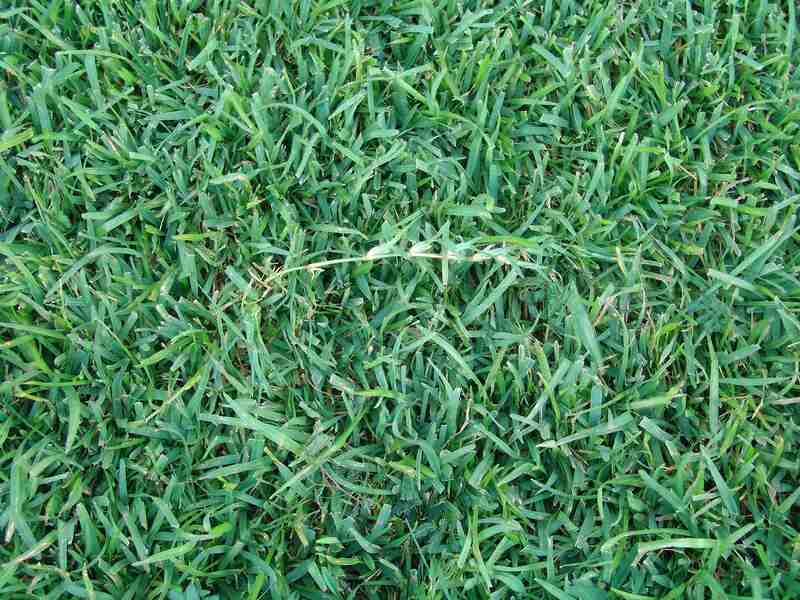
Photo Credit: James Becwar / Wikimedia Commons / CC0 1.0
Bermudagrass, also called wiregrass, is a dense, low-maintenance grass that grows in various soil conditions and thrives in hot, sunny climates. Its colors normally range from light to dark green. It doesn’t need much water, grows in most soil conditions, and can handle drought well. All these advantages make this grass a desirable choice for many LA homeowners.
Moreover, Bermudagrass is perfect for high-traffic areas because it tolerates wear and tear. In fact, it spreads so rapidly that it needs to be mowed frequently and can be invasive if not properly contained.
There are different types of Bermudagrass, from the low-maintenance common Bermudagrass to the high-maintenance hybrid Bermudagrass with a fine texture. Be sure to choose a type that works for you and meets your expectations and preferences.
Classification: Warm-season grass
Spreads by: Stolons and rhizomes (rapidly)
Drought tolerance: High, but may turn brown and dormant in an extended drought
Foot traffic tolerance: High; grows back quickly after suffering damage
Shade tolerance: Low; some varieties are more shade-tolerant than others
Maintenance needs: Moderate; needs mowing once or twice per week and is susceptible to many pest and disease problems
Recommended mowing height: 1 to 2 inches
4. California Buffalograss
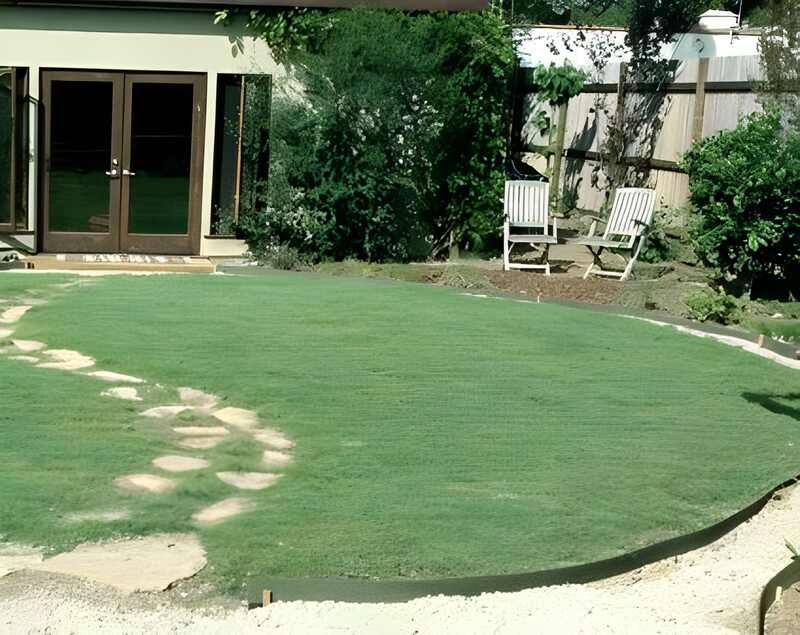
Photo Credit: Susan Harris / Flickr / CC BY 2.0
California buffalograss, formerly known as UC Verde, is a cultivar of native buffalograss that’s better suited for use in California. This grass is drought-tolerant and dense. It’s a low-maintenance option that requires less water than some of the other grass types. Moreover, it needs little to no chemical treatment and produces less pollen.
You can let your California buffalograss grow freely for a meadow-like look or mow it regularly for a more traditional lawn appearance. In any case, this bright green grass is soft to the touch and tolerates moderate foot traffic, making it an excellent option for your lawn during the summer.
One thing about the California buffalograss: It gets weedy until it’s well-established. Installing sod may be easier. Once established, however, California buffalograss resists weeds.
- Classification: Warm-season grass
- Spreads by: Stolons
- Shade tolerance: Low
- Drought tolerance: High; will turn brown during summer if left unirrigated; needs about 0.5 inches of water per week
- Foot traffic tolerance: Moderate
- Maintenance needs: Low
- Recommended mowing height: Up to you; naturally grows up to 4 to 6 inches tall; never remove more than 1/3 of the leaf blade per mow
5. St. Augustinegrass
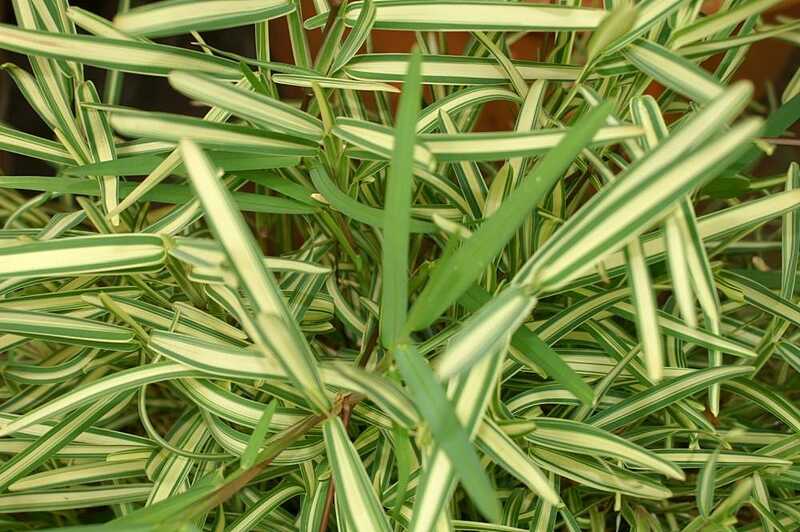
Photo Credit: David J. Stang / Wikimedia Commons / CC BY-SA 4.0
If you just can’t wait to see your new grass, St. Augistinegrass may be a fitting choice for you. This grass germinates quickly, making it ideal for those who want to see results quickly. It’s a blue-green grass with a coarse texture and medium density. Unlike some other warm-season grass types, St. Augustinegrass does well in partial shade.
On the other hand, St. Augustinegrass doesn’t withstand drought, heavy foot traffic, and other stresses as well as other grass types. So if you choose it, make sure to provide it with adequate water and care and avoid excessive wear.
Classification: Warm-season grass
Spreads by: Stolons
Drought tolerance: Low; requires regular watering during dry periods to stay healthy
Foot traffic tolerance: Low
Shade tolerance: Moderate; some cultivars are more shade-tolerant than others
Maintenance needs: High; requires regular irrigation and fertilization to grow healthy
Recommended mowing height: 3.5 to 4 inches for standard cultivars; 2 to 2.5 inches for dwarf cultivars
6. Zoysiagrass
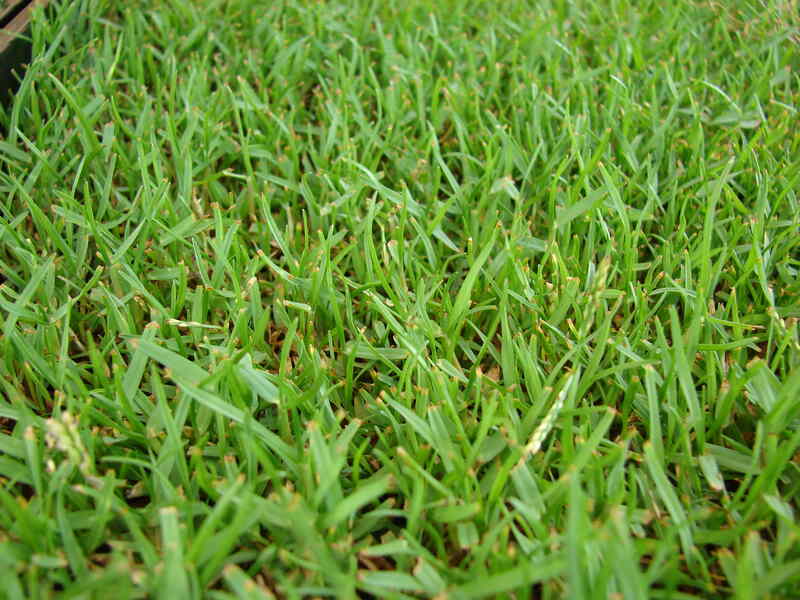
Photo Credit: Forest and Kim Starr / Flickr / CC BY 2.0
A number of homeowners favor zoysiagrass for its dense, carpet-like appearance and its ability to handle drought and thrive in various soils. This grass also withstands foot traffic quite well, making it suitable for busy lawns.
However, this grass is known for its high maintenance needs, too. It needs regular fertilization and supplemental watering to thrive. It may also need pesticides because it is vulnerable to certain pests.
Additionally, because zoysiagrass is so dense, thatch builds up rapidly and must be removed frequently. The grass takes a while to grow, which might make sod a better option, but it’s also more expensive.
Classification: Warm-season grass
Spreads by: Stolons and rhizomes
Drought tolerance: Low; requires supplemental watering, especially during dry periods
Foot traffic tolerance: High; dense growth resists damage, and spreading through stolons and rhizomes allows for quick recovery
Shade tolerance: High
Maintenance needs: Higher maintenance than many other grass types
Recommended mowing height: Depends on the species and cultivar; ranges from 0.25 to 2.5 inches
FAQ About Grass Types for Los Angeles
It depends on a variety of factors, such as your grass species and soil type. So, make sure that you research the specific needs of your lawn. In general, the University of California Agriculture and Natural Resources says that grass should be watered about once or twice a week.
If you want a low-maintenance lawn in Los Angeles, your options are narrowed down to three grass types:
● Sand dune sedge grows in clumps and won’t look like a traditional lawn, but it doesn’t need much water or mowing
● California buffalograss was developed specifically for California, and you can keep it as long or as short as you like, but it might be a challenge to keep it weed-free before it establishes
● California bentgrass is easy to take care of, too; you can either let it grow freely or mow it, but if you prefer the latter, you’ll need to mow it continually to avoid scalping; it also takes longer to grow and its sod is more expensive than alternatives
If you have a busy lawn, there are grasses that can withstand foot traffic and grow back quickly after damage. The best Los Angeles grass types for a lot of foot traffic are:
● Native California bentgrass
● Bermudagrass
● Zoysiagrass
If you like a bit of shade on your lawn, the best grass types for a shady Los Angeles lawn are:
● Native California bentgrass
● Zoysiagrass
● Some varieties of St. Augustinegrass
● A few varieties of Bermudagrass
If you have pets, it’s recommended that you choose a grass type that’s pet-friendly. You can choose between these two warm-season types of grass:
Bermudagrass: is low-maintenance; tolerates a variety of conditions and wear and tear; spreads so quickly that it can become invasive; has a high drought tolerance; but can’t handle shade
Zoysiagrass: its dense growth discourages digging; it can spread dead patches from pet urine; it’s tolerant of shade and various kinds of soil; however, it also has a low drought tolerance and is high-maintenance
Although both of these grass types may be suitable for pets, they have different advantages and disadvantages. It’s important to consider your specific needs and the conditions of your lawn before you decide which grass to get.
Choose the Right Grass and Plants for Your LA Landscape
Establishing a new lawn is an exciting experience, but you want to make sure that you’re choosing the right grass type. To sum it up, there are various kinds of grasses suitable for Los Angeles. The right choice depends on factors such as:
- Your maintenance preferences
- The look and feel you’re going for
- Whether or not you have pets
- How busy your lawn gets
- How much shade there is
- And so forth
Additionally, it’s important to consider other elements of your yard. If you, for instance, want to plant shrubs or flowers, you should research the best native plants for Los Angeles that will thrive in your specific climate and soil conditions.
You’ll then need to provide your Los Angeles lawn with adequate care throughout the year. This includes, but is not limited to, grass aeration, fertilizing, overseeding, watering, and more. Correct lawn maintenance is needed to help it stay green and lush, so make sure you research all the necessary steps.
If you’d like a pro to take care of your lawn for you, you can get quotes from WikiLawn’s Los Angeles lawn care pros.

